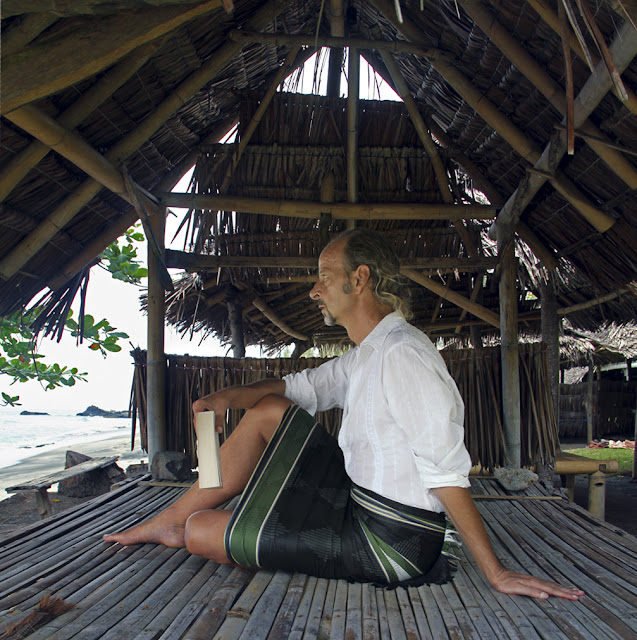Paradise Found – An Interview With Photographer Fred Stichnoth
Growing up, Fred Stichnoth was always drawn to adventure movies set in tropical locations. “I love ancient themes, from Egypt to Indonesia. I’ve spent a long time travelling around the world, being drawn to what is considered taboo,” he says. So, it was a dream come true when he located from his native Germany to the Indonesian Island of Bali. From here he has been able to explore some of the remotest areas in the East Indies and the tribes that call these places home. A home that is fast disappearing, along with their customs, legends, ceremony and regalia.
When the world is at your feet, turning your back on it is a big call. But most of us are not Fred Stichnoth. The German-born, Bali-based photographer relinquished life as a celebrity and fashion photographer in the late nineties, where he was poised for popularity, in order to decamp to the East Indies and collect shells. It’s a move that has yielded a distinctive body of work. Stichnoth’s portraiture bears the hallmarks of his haute couture pedigree, applied to natural and exotic subjects.
Stichnoth’s portraiture studies the beauty of women and ethnic culture using a unique combination borne out of necessity and unconscious influence. He employs an old fashioned technique whereby a backdrop is used to separate the subject from their surroundings. This juxtaposition is striking when the subject is so obviously separated from their natural environment. He also uses motifs and poses that echo the stylised productions in fashion magazines. The final picture comes together like an ethereal sculpture, caught on photographic paper.
“Around 1860 photographers began using things like a simple bed sheet to create a neutral background. I followed this old idea so as not to disturb or detract from the main focus of the image.” ~ Fred Stichnoth
Continue reading to learn more about Fred Stichnoth.
Why did you have to decamp to the East Indies in the late nineties?
The point was reached where I knew that I could not expand my career as a photographer in Germany. I had to move to Paris, London or New York, one of the fashion capitals, to work at a higher level. I had fallen in love with fashion photography but I also had a desire to create my own visions, realise my own ideas, far from Europe.
I decided on something completely new – a new adventure. The longing for peace, turquoise waters and nature was the driving force behind my decision to change my life completely.
As soon as I arrived in Indonesia, there was no real contact with my previous life in Germany. I was one hundred percent in my new place. My paradise had been found.
Who influenced your photography style as an Haute couture photographer?
First and foremost, I must say my mentor, German portrait artist Walter Schels, who I worked for at the beginning of my career. He was well known for his portraits of people from all walks of life from celebrities to politicians. He was intrumental in steering the direction of my style.
Also, the legendary photographers who worked for Vogue Italia – one of the best fashion magazines in the world. Image makers such as Mario Testino, Steven Meisel, Richard Avedon, Irving Penn to name a few. They certainly shaped my photography and inspired me.
At the end of the day, if you stick at it long enough, at some point you will find and develop your own style.
Fred Stichnoth studied photography using large format cameras as an assistant to German portrait artist, Walter Schels
Who are some of the prominent stars and celebrities you have photographed?
Interesting question... for me it is currently the protagonists I photographed for my East Indies project. Unknown stars.
What is most important in your life? What is your philosophy?
The most important thing in my life is creativity. To have an idea, to work on it, to make it happen.
Enthusiasm. To do good work is my philosophy. To inspire others, to do something positive, to create a new awareness. Something that stays. I think my East Indies photography does this.
I hope by capturing and sharing the tribes I encounter, it might increase our awareness to preserve these ancient civilisations a little longer. I just want to capture it before it disappears.
How difficult was it to achieve the kind of minimalist portraiture like the "Young Woman With Hornbill Headdress"?
The preparation is not easy. First and foremost, I need to build a level of trust and comfort with my ‘model’.
My years as a fashion photographer have been very helpful for me in order to style different sittings. The costumes of indigenous tribes, for instance, are fashion in their own way, and they continue to change and develop.
There is no commercial idea or client brief, no customer, no makeup or styling team. If something doesn’t work, it is my mistake.
Without the disturbance of others and outsiders, I can look for the ultimate photo.
The moment of capturing the image is the easy part. It’s about spirituality, simplicity. Such a session must flow... pure love. Everything has to be "one" and in sync. It’s about finding joy in simplicity.
I am touched by the visual richness of different cultures: their beauty, their simplicity, their pride.








